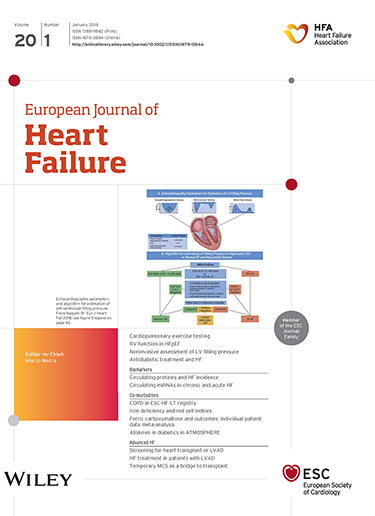Insights into the European heart failure epidemiology
IF 16.9
1区 医学
Q1 CARDIAC & CARDIOVASCULAR SYSTEMS
引用次数: 0
Abstract
AimsThe Heart Failure Association (HFA) of the European Society of Cardiology (ESC), together with the National Heart Failure Societies (NHFS), designed the European Heart Failure (HF) Survey with an aim of assessing contemporary HF epidemiology, management resources, availability and reimbursement of guideline‐directed medications and devices, and structure of professional and patient organizations. This document presents data on HF epidemiology.Methods and resultsThe European HF Survey was conducted in 43 ESC member countries. Epidemiology data were exclusively collected from national health statistics from 2019, and standardized according to the European Standard Population, with variable response rates and data completeness among the countries. Median annual HF incidence was 3.9 patients per 1000 person‐years (interquartile range [IQR] 3.1–6.5), and median HF prevalence was 1937 patients (IQR 1463–3416) per 100 000 population. Median in‐hospital mortality of patients admitted for HF was 8.0% (IQR 4.9–9.6%), and median 1‐year all‐cause mortality of patients with HF was 14.5% (IQR 8.2–21.6%). Median number of HF‐related hospitalizations was 333 (IQR 230–469) per 100 000 population, and median length of stay for HF‐related hospitalizations was 8.5 (IQR 7.2–9.2) days. A heterogeneity in HF epidemiology statistics was observed across different countries.ConclusionsThe European欧洲心力衰竭流行病学研究
欧洲心脏病学会(ESC)的心力衰竭协会(HFA)与国家心力衰竭协会(NHFS)一起设计了欧洲心力衰竭(HF)调查,目的是评估当代心力衰竭流行病学、管理资源、指南指导药物和器械的可用性和报销,以及专业和患者组织的结构。本文介绍了心衰流行病学的数据。方法和结果欧洲心力衰竭调查在43个ESC成员国进行。流行病学数据仅从2019年的国家卫生统计数据中收集,并根据欧洲标准人口进行标准化,各国的响应率和数据完整性各不相同。年HF发病率中位数为3.9例/ 1000人-年(四分位数范围[IQR] 3.1-6.5),中位HF患病率为1937例/ 10万人(IQR: 1463-3416)。心力衰竭住院患者的中位死亡率为8.0% (IQR为4.9-9.6%),心力衰竭患者1年全因死亡率中位为14.5% (IQR为8.2-21.6%)。每10万人中与HF相关的住院人数中位数为333 (IQR 230-469),与HF相关的住院时间中位数为8.5 (IQR 7.2-9.2)天。不同国家的心衰流行病学统计数据存在异质性。结论:欧洲心衰调查提供了ESC成员国心衰流行病学和结果的当代见解。这些数据对改善心衰的预防、诊断和管理策略具有重要价值。流行病学统计中持续存在的差距和相当大的异质性突出表明需要进一步统一欧洲各国的数据收集和报告做法。
本文章由计算机程序翻译,如有差异,请以英文原文为准。
求助全文
约1分钟内获得全文
求助全文
来源期刊

European Journal of Heart Failure
医学-心血管系统
CiteScore
27.30
自引率
11.50%
发文量
365
审稿时长
1 months
期刊介绍:
European Journal of Heart Failure is an international journal dedicated to advancing knowledge in the field of heart failure management. The journal publishes reviews and editorials aimed at improving understanding, prevention, investigation, and treatment of heart failure. It covers various disciplines such as molecular and cellular biology, pathology, physiology, electrophysiology, pharmacology, clinical sciences, social sciences, and population sciences. The journal welcomes submissions of manuscripts on basic, clinical, and population sciences, as well as original contributions on nursing, care of the elderly, primary care, health economics, and other related specialist fields. It is published monthly and has a readership that includes cardiologists, emergency room physicians, intensivists, internists, general physicians, cardiac nurses, diabetologists, epidemiologists, basic scientists focusing on cardiovascular research, and those working in rehabilitation. The journal is abstracted and indexed in various databases such as Academic Search, Embase, MEDLINE/PubMed, and Science Citation Index.
 求助内容:
求助内容: 应助结果提醒方式:
应助结果提醒方式:


